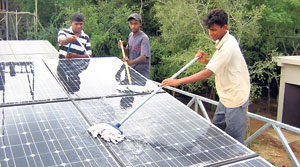It’s not something you’d expect to find in the middle of a paddy field in a distant village, but Sri Lanka’s largest solar panel installation is exactly where it belongs. A crucial component of a new luxury eco-resort, the solar panels will supply 25 chalets with electricity. In peak season, it might have to draw off the grid, but in the off season, it will actually have enough to give back.
Combined with several other initiatives, the solar panel farm allows the owners of the Ulagalla Walawwa Resort at Thiripane to boast of strong eco-credentials.
The 50 by 20 square metres of panels took six months to put into place, says Upendra Weerasuriya, Managing Director of Nikini Automation Systems Pvt Ltd. Mr. Weerasuriya, who was in the news when his four storey office became Sri Lanka’s first zero energy building, is an ardent promoter of solar energy. His newest installation can generate around 600 kilowatt hours on a good day, leading to nearly 400 kilograms in carbon savings.
The solar panels, composed of a layer of glass over silicone chips, come with a twenty year warranty, and have been imported from Japan. Other components, such as the invertors that convert the panel’s D.C electricity into A.C electricity, are German made.
In an interesting twist, the panels have been laid over the roof of the hotel’s stables. Divided into 12 sections, the panels are especially designed and ceiled so that they can also channel rain water for harvesting. Large tanks under the panels store the water. Inquisitive wild life must be protected, and all crucial cables are covered with metal sheets to prevent them biting through. Despite other such custom elements, the cost of the installation is 20% less than it was two years ago when Mr. Weerasuriya built his own office – prices have become more competitive as more manufacturers commit to solar energy.
In countries like Singapore, China and India, the government provides strong incentives, for private companies who generate solar power. “In Sri Lanka, however, we don’t have a tariff rate,” says Mr. Weerasuriya, explaining that other renewable energy sources like wind and hydro have a tariff rate set by the sustainable energy authority.
The current arrangement allows for connection to the grid where any excess generated can be offset from your bill. Mr. Weerasuriya looks forward to the day when solar power will have “grid parity” – where such alternative sources will cost the same amount or even less than grid power. |


